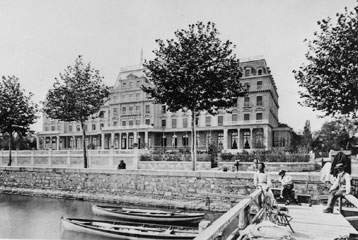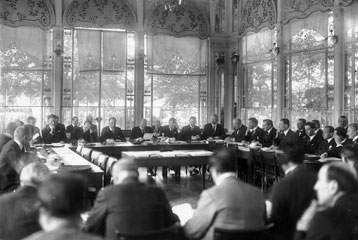The League of Nations was the first international peace-keeping institution.
At the end of World War One in 1918, Europe was reeling. A peace agreement had been reached but it did not look as if it would last. The loss of human life had been huge and the European economy was suffering. Severely sanctioned, Germany was very unhappy at the resolutions adopted by the Treaty of Versailles, while France continued to be wary of its Germanic neighbour. Against this backdrop, it was necessary to create an organisation capable of keeping the peace in Europe. Under the key impetus of US President Woodrow Wilson, the League of Nations (LoN) was created in February 1919.
An institution dedicated to peace
The League of Nations was born of a desire never to relive the bloodbath of World War One. It was a major historical turning point: the LoN was the first organisation that took an institutional approach to international affairs. This institution dedicated to peace had clearly defined objectives, the main ones being:
- to ensure compliance with international law, with the help of the Permanent Court of International Justice (PCIJ);
- to abolish secret diplomacy, which was widespread before 1914;
- to resolve conflicts by arbitration.
US President Woodrow Wilson was the main architect behind this project. Initially reticent, the European powers finally ratified the LoN project. The American Congress, however, opposed its country’s membership of the League of Nations. Consequently, the first assembly of the League of Nations was held on 15 November 1920 in Geneva without President Wilson.
Why Geneva?
The choice of the City of Geneva as headquarters of the LoN was not insignificant. Since 1863, Geneva had been home to the International Committee of the Red Cross (ICRC). It was nevertheless primarily thanks to the joint efforts of Federal Councillor Gustave Ador and the economist William E. Rappard that the City of Geneva was preferred to Brussels or The Hague. Following a popular vote won by the smallest of majorities, Switzerland joined the new international organisation in May 1920. This date marks the true beginning of the international role of Geneva.
The Palais Wilson
It was in the largest room in Geneva, the Salle de la Réformation, that the first assemblies of the League of Nations were held. Built in 1866 at the corner of Boulevard Helvétique and Rue du Rhône, this spacious conference room housed the international debates until the League of Nations moved to the Palais Wilson. This former palace, built on the shores of Lake Geneva, was home to the Secretariat of the LoN and most of its activities during almost the entire inter-war period. Named in 1924 in homage to the main driving force behind the League of Nations, the Palais Wilson is the true symbol of the LoN. Today, it houses the Office of the United Nations High Commissioner for Human Rights.
Hope for universal peace
The League of Nations’ move to the Palace of Nations (the current home of the UN) coincided with the end of a dream. Undermined by the tensions between the major powers and by the departure of certain states from its council, the LoN appeared doomed to fail. The outbreak of World War Two highlighted the scale of the fiasco, and the LoN disappeared… to be replaced in 1946 by its direct heir, the United Nations. Despite its disappearance, the League of Nations played a major role in establishing a collective project aimed at keeping the peace.
Liens externes
Article modifié le 02.03.2020 à 14:26


